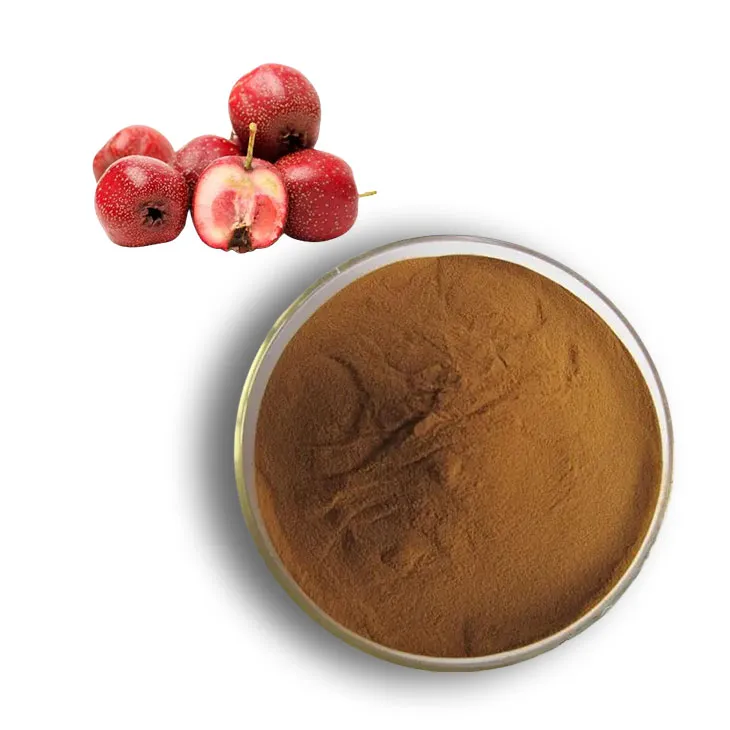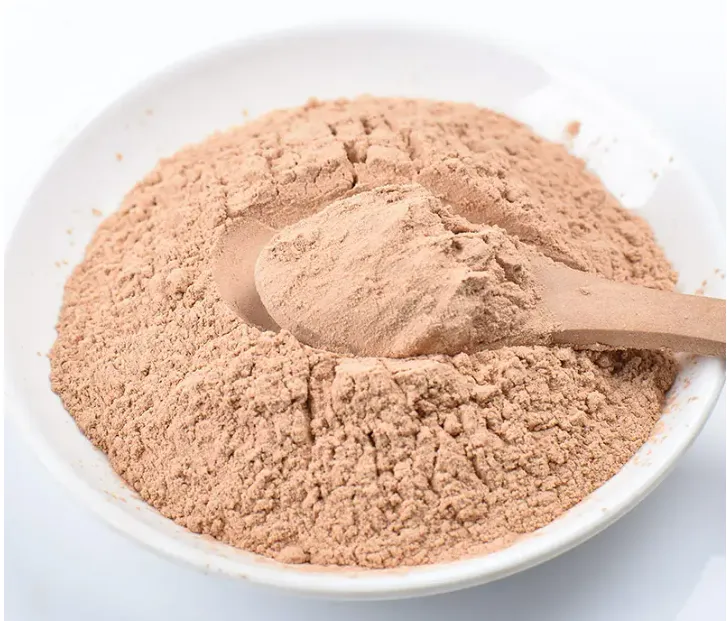- 0086-571-85302990
- sales@greenskybio.com
Organic Hawthorn Extract of Trace Components.
2024-11-29

1. Introduction to Organic Hawthorn Extract
Micro - component organic Hawthorn Extract has emerged as a significant subject in various fields. Hawthorn, Crataegus pinnatifida, is a well - known plant that has been used in traditional medicine for centuries. It is native to Asia, Europe, and North America. The plant contains a rich variety of substances, and the organic Hawthorn Extract, with its trace components, is garnering increasing attention.

2. Bioactive Trace Components in Hawthorn Extract
These trace components are often bioactive substances that can have diverse physiological effects.
2.1 Cardiovascular Health Benefits
For example, it may play a role in promoting cardiovascular health. Compounds within the extract might help regulate blood pressure and cholesterol levels. Some of the bioactive components are believed to have vasodilatory effects, which can relax the blood vessels and reduce the resistance to blood flow. This, in turn, can help in lowering blood pressure. Additionally, certain substances in the hawthorn extract may interfere with the absorption or synthesis of cholesterol in the body, thereby contributing to better cholesterol management.
2.2 Anti - inflammatory Properties
Some of the trace components in the organic hawthorn extract are also thought to possess anti - inflammatory properties. Inflammation is a key factor in many chronic diseases, such as heart disease, arthritis, and diabetes. By reducing inflammation, the hawthorn extract may potentially help in the prevention and management of these diseases. The anti - inflammatory effects may be due to the presence of flavonoids and other phenolic compounds in the extract.

3. Applications in the Food and Beverage Industry
In the field of food and beverage, the organic hawthorn extract can be used as a natural flavor enhancer.
3.1 Flavor Profile
It adds a unique tart and fruity flavor. The tartness of the hawthorn extract can provide a refreshing taste to various products. It can be used in the production of juices, jams, and candies. For example, in hawthorn - flavored juices, the extract not only imparts its characteristic flavor but also brings with it the potential health benefits associated with the bioactive components.
3.2 Functional Food Ingredient
Moreover, it can be used as a functional food ingredient. With the increasing consumer demand for healthy and natural products, the hawthorn extract can be added to foods to enhance their nutritional value. It can be incorporated into breakfast cereals, energy bars, and dietary supplements.

4. Potential in the Cosmetic Industry
It also has potential applications in the cosmetic industry.
4.1 Antioxidant Properties
As it may possess antioxidant properties that can contribute to skin health, such as protecting against oxidative stress. Oxidative stress is caused by an imbalance between the production of free radicals and the body's ability to detoxify them or repair the resulting damage. Free radicals can damage the skin cells, leading to premature aging, wrinkles, and dull skin. The antioxidant components in the hawthorn extract can scavenge these free radicals, thereby protecting the skin.
4.2 Skin - Conditioning Effects
In addition to its antioxidant properties, the hawthorn extract may also have skin - conditioning effects. It can help to moisturize the skin, improve skin elasticity, and reduce the appearance of fine lines and wrinkles. These effects may be due to the presence of certain fatty acids and polysaccharides in the extract. It can be used in the formulation of creams, lotions, and masks for various skin types.
5. Extraction and Isolation of Trace Components
The extraction and isolation of trace components from hawthorn are crucial steps in obtaining a high - quality organic hawthorn extract.
5.1 Extraction Methods
There are several extraction methods available, including solvent extraction, supercritical fluid extraction, and microwave - assisted extraction. Solvent extraction is the most commonly used method, where organic solvents such as ethanol or methanol are used to extract the bioactive components from the hawthorn. Supercritical fluid extraction, using carbon dioxide as the supercritical fluid, is a more advanced method that offers advantages such as higher selectivity and lower environmental impact. Microwave - assisted extraction is a relatively new method that can significantly reduce the extraction time and improve the extraction efficiency.
5.2 Isolation and Purification
After extraction, the next step is isolation and purification of the trace components. This can be achieved through techniques such as chromatography, which includes high - performance liquid chromatography (HPLC) and gas chromatography (GC). These techniques can separate the different components based on their chemical properties, allowing for the isolation of the desired bioactive substances.
6. Quality Control and Standardization
Quality control and standardization are essential aspects in the production of organic hawthorn extract.
6.1 Quality Control Parameters
Quality control parameters include the identification and quantification of the bioactive components, as well as the determination of contaminants such as heavy metals, pesticides, and mycotoxins. Analytical techniques such as spectroscopy and chromatography are used to monitor these parameters. For example, ultraviolet - visible spectroscopy can be used to detect the presence of certain flavonoids, while HPLC can be used for their quantification.
6.2 Standardization
Standardization of the extract is necessary to ensure consistent quality and efficacy. This involves establishing a set of specifications for the extract, including the content of the bioactive components, physical and chemical properties, and microbiological quality. Standardized extracts can be more easily incorporated into various products and can provide more reliable results in terms of their health benefits and applications.
7. Future Research and Development
There is still much to be explored in the field of organic hawthorn extract of trace components.
7.1 Identification of New Bioactive Components
Future research could focus on the identification of new bioactive components in the hawthorn extract. Although many components have already been identified, there may be other substances with potential health benefits that are yet to be discovered. Advanced analytical techniques such as metabolomics could be used to comprehensively profile the components in the extract.
7.2 Clinical Trials
Clinical trials are also needed to further validate the health benefits of the hawthorn extract. While there is some evidence from in - vitro and animal studies, human clinical trials are essential to confirm the efficacy and safety of the extract for various applications, such as in the treatment of cardiovascular diseases or in cosmetic use.
7.3 New Applications
Furthermore, research could be directed towards exploring new applications of the hawthorn extract. For example, in the field of nutraceuticals, new formulations could be developed to target specific health conditions. In the cosmetic industry, novel delivery systems could be explored to enhance the penetration and effectiveness of the extract on the skin.
8. Conclusion
In conclusion, the organic hawthorn extract of trace components is a promising area of research and development. Its bioactive components offer a wide range of potential health benefits and applications in various industries. However, further research is needed to fully understand its mechanisms of action, identify new components, and validate its efficacy through clinical trials. With proper extraction, quality control, and standardization, the hawthorn extract can be effectively utilized in food, beverage, cosmetic, and other industries, providing consumers with natural and healthy products.
FAQ:
What are the main bioactive substances in the organic hawthorn extract?
The main bioactive substances in the organic hawthorn extract are often those trace components. These can include various compounds such as flavonoids, which are known for their potential to have physiological effects like regulating blood pressure and cholesterol levels, among others.
How does the organic hawthorn extract promote cardiovascular health?
The compounds within the organic hawthorn extract may promote cardiovascular health in multiple ways. For example, some substances might help relax blood vessels, which can contribute to better blood pressure regulation. Others may have an impact on cholesterol metabolism, potentially reducing harmful cholesterol levels in the body.
What makes the organic hawthorn extract a good natural flavor enhancer in food and beverage?
The organic hawthorn extract has a unique tart and fruity flavor. This characteristic flavor makes it an excellent choice as a natural flavor enhancer in food and beverage products, adding a distinct taste that can enhance the overall flavor profile.
How can the antioxidant properties of the organic hawthorn extract benefit skin health?
The antioxidant properties of the organic hawthorn extract can benefit skin health by protecting against oxidative stress. Oxidative stress can cause damage to skin cells, leading to signs of aging such as wrinkles and dull skin. The antioxidants in the extract can neutralize free radicals, reducing these signs of aging and contributing to overall healthier skin.
Are there any potential side effects of using the organic hawthorn extract?
While generally considered safe, in some cases, the use of organic hawthorn extract may cause minor side effects. For example, some people may experience mild digestive discomfort. However, this is relatively rare and usually occurs at very high doses or in individuals with specific sensitivities. It is always advisable to consult a healthcare professional before using any extract in large amounts or for medicinal purposes.
Related literature
- Analysis of Trace Components in Organic Hawthorn Extract and Their Bioactivities"
- "The Role of Organic Hawthorn Extract in Cardiovascular Health: A Comprehensive Review"
- "Organic Hawthorn Extract as a Natural Flavor and Its Applications in the Food Industry"
- ▶ Hesperidin
- ▶ citrus bioflavonoids
- ▶ plant extract
- ▶ lycopene
- ▶ Diosmin
- ▶ Grape seed extract
- ▶ Sea buckthorn Juice Powder
- ▶ Beetroot powder
- ▶ Hops Extract
- ▶ Artichoke Extract
- ▶ Reishi mushroom extract
- ▶ Astaxanthin
- ▶ Green Tea Extract
- ▶ Curcumin Extract
- ▶ Horse Chestnut Extract
- ▶ Other Problems
- ▶ Boswellia Serrata Extract
- ▶ Resveratrol Extract
- ▶ Marigold Extract
- ▶ Grape Leaf Extract
- ▶ blog3
- ▶ Aminolevulinic acid
- ▶ Cranberry Extract
- ▶ Red Yeast Rice
- ▶ Red Wine Extract
-
White Willow Bark Extract
2024-11-29
-
Eucommia Ulmoides Extract
2024-11-29
-
Lycopene
2024-11-29
-
Chasteberry Extract
2024-11-29
-
Selenium yeast
2024-11-29
-
Lily extract
2024-11-29
-
Artichoke Leaf Extract
2024-11-29
-
Avocado Extract Powder
2024-11-29
-
Sea buckthorn oil
2024-11-29
-
Dandelion Leaf Extract
2024-11-29





















